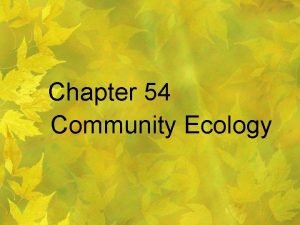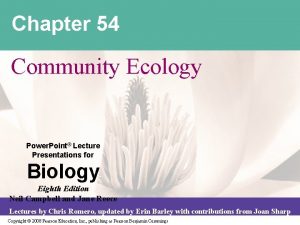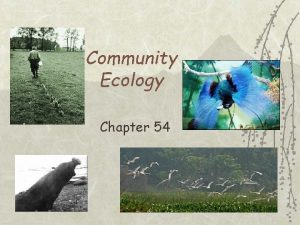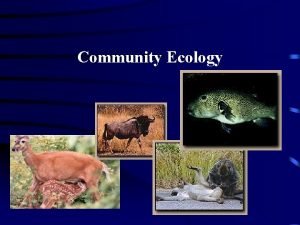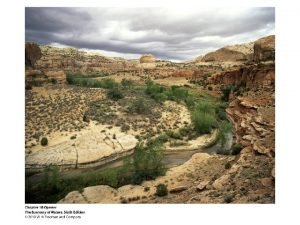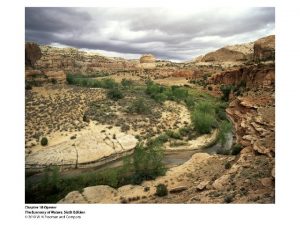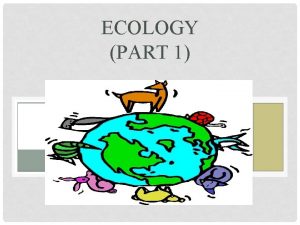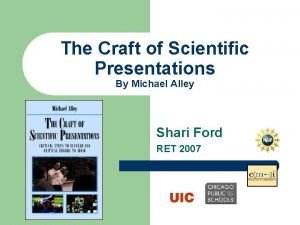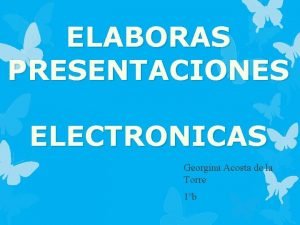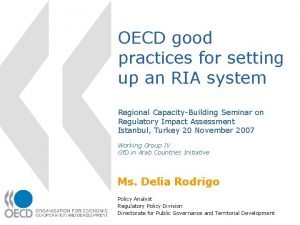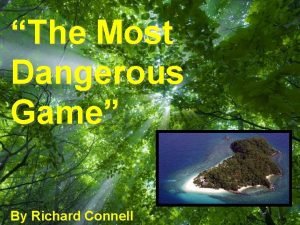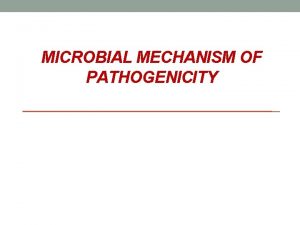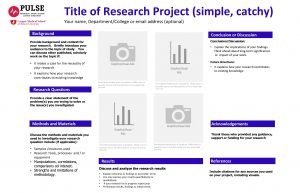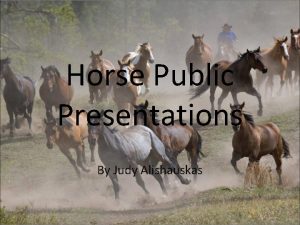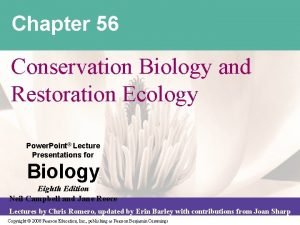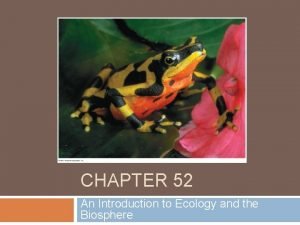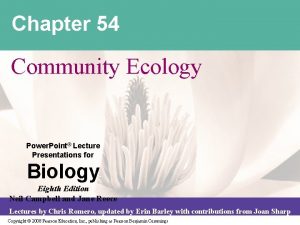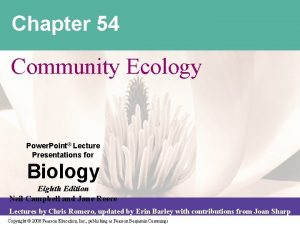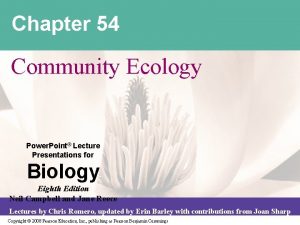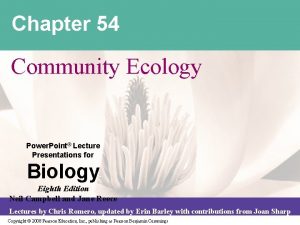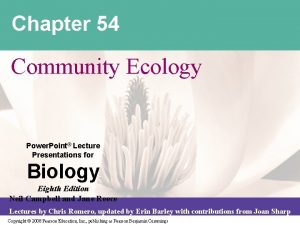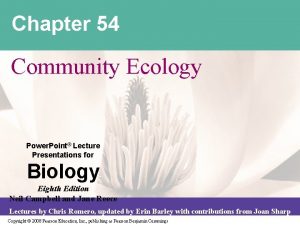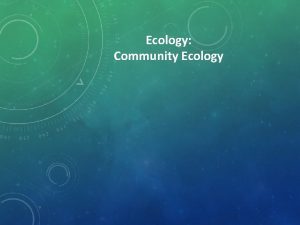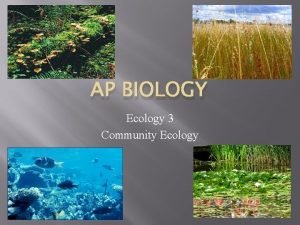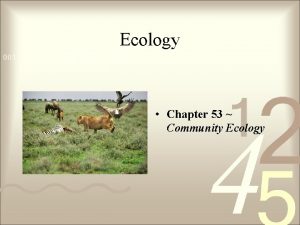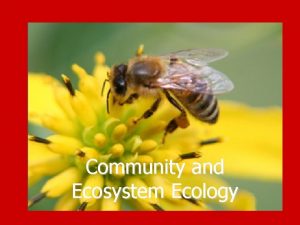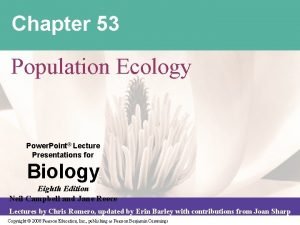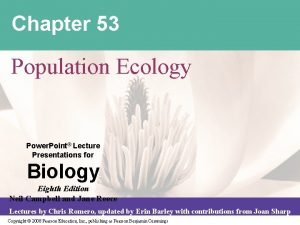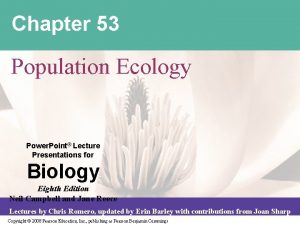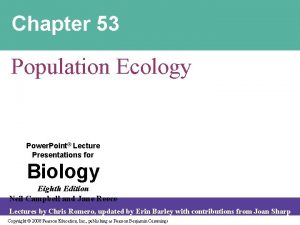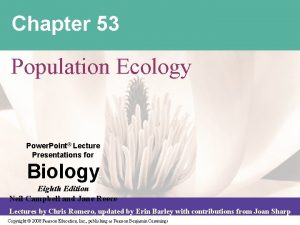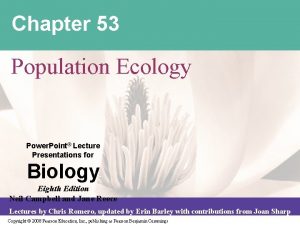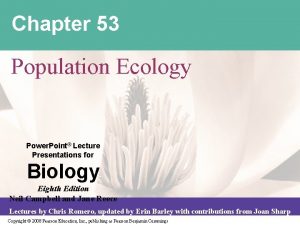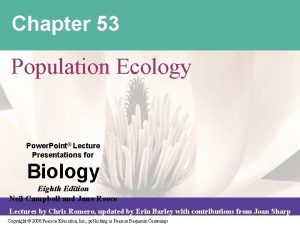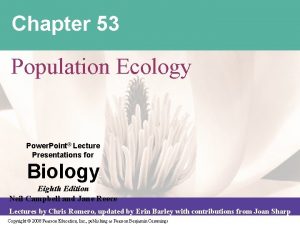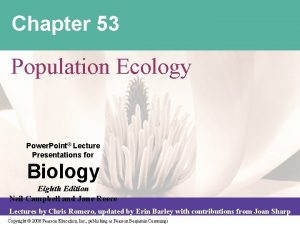Chapter 54 Community Ecology Power Point Lecture Presentations



































































- Slides: 67

Chapter 54 Community Ecology Power. Point® Lecture Presentations for Biology Eighth Edition Neil Campbell and Jane Reece Lectures by Chris Romero, updated by Erin Barley with contributions from Joan Sharp Copyright © 2008 Pearson Education, Inc. , publishing as Pearson Benjamin Cummings

Overview: A Sense of Community • A biological community is an group of populations of various species living close enough for potential interaction Copyright © 2008 Pearson Education, Inc. , publishing as Pearson Benjamin Cummings

Concept 54. 1: Community interactions are classified by whether they help, harm, or have no effect on the species involved • Relationships between species in a community are called interspecific interactions • Examples: competition, predation, herbivory, and symbiosis (parasitism, mutualism, and commensalism) • Interspecific interactions affect the survival and reproduction of each species • the effects can be (+), (–), or no effect (0) Copyright © 2008 Pearson Education, Inc. , publishing as Pearson Benjamin Cummings

Competition • Interspecific competition (–/– interaction) occurs when species compete for a resource in short supply In Alaska, the lynx and the fox must compete with each other for prey such as the snowshoe hare. Copyright © 2008 Pearson Education, Inc. , publishing as Pearson Benjamin Cummings

Competitive Exclusion • Strong competition can lead to competitive exclusion, local elimination of a competing species • The competitive exclusion principle states that two species competing for the same limiting resources cannot coexist in the same place – One species will be more efficient and thus reproduce more rapidly than the other. This will eventually lead to the local elimination of the inferior competitor. Copyright © 2008 Pearson Education, Inc. , publishing as Pearson Benjamin Cummings

Ecological Niches • Ecological niche --The total of a species’ use of biotic and abiotic resources • In other words…a niche is an organism’s ecological role (its “job”) • Similar species can coexist in a community if there are one or more significant differences in their niches Copyright © 2008 Pearson Education, Inc. , publishing as Pearson Benjamin Cummings

• Resource partitioning is differentiation of ecological niches, enabling similar species to coexist in a community – Ex: Seven species of Anolis Lizards live close together in the Dominican Republic. They all eat the same food. Competition, however, is reduced because each lizard species has a preferred perch, thus occupying a distinct niche. Copyright © 2008 Pearson Education, Inc. , publishing as Pearson Benjamin Cummings

Fig. 54 -2 A. distichus perches on fence posts and other sunny surfaces. A. insolitus usually perches on shady branches. A. ricordii A. insolitus A. aliniger A. distichus A. christophei A. cybotes A. etheridgei

• As a result of competition, a species’ fundamental niche may differ from its realized niche – Fundamental niche = niche potentially occupied – Realized niche = part of the niche actually occupied Copyright © 2008 Pearson Education, Inc. , publishing as Pearson Benjamin Cummings

Fig. 54 -3 EXPERIMENT Chthamalus Two barnacle species have a stratified distribution on coastal rocks. Is this the result of interspecific competition between the two? Balanus Chthamalus realized niche Balanus realized niche To find out, researchers removed the Balanus from the rocks. Ocean Results were that the Chthamalus moved into the area formerly occupied by Balanus. Thus, interspecific competition makes the realized niche of Chthamalus much smaller than its fundamental niche High tide RESULTS Knowing that Balanus cannot survive high on the rocks because it dries out during low tides, how does its realized Ocean niche compare with its fundamental niche? Low tide High tide Chthamalus fundamental niche Low tide

Character Displacement • Character displacement is a tendency for characteristics to be more divergent in populations that are geographically overlapping rather than populations that are geographically separate • An example is variation in beak size between populations of two species of Galápagos finches – Where these two species live separately, their beak sizes are about the same---indicating they eat the same seeds. – Where they live together (on Santa Maria and San Cristobal) they must compete for food and overtime have evolved differences that allow for different beak sizes thus, eating different seeds. Copyright © 2008 Pearson Education, Inc. , publishing as Pearson Benjamin Cummings

Fig. 54 -4 G. fuliginosa G. fortis Percentages of individuals in each size class Beak depth 60 Los Hermanos 40 G. fuliginosa, allopatric 20 0 60 Daphne 40 G. fortis, allopatric 20 0 60 Santa María, San Cristóbal 40 Sympatric populations 20 0 8 10 12 Beak depth (mm) 14 16

Predation • Predation (+/– interaction) refers to interaction where one species, the predator, kills and eats the other, the prey • Some feeding adaptations of predators are claws, teeth, fangs, stingers, and poison Copyright © 2008 Pearson Education, Inc. , publishing as Pearson Benjamin Cummings

• Prey display various defensive adaptations Behavioral defenses include hiding, fleeing, forming herds or schools, selfdefense, and alarm calls Animals also have morphological and physiological defense adaptations such as: Canyon Tree Frog Cryptic coloration, or camouflage, makes prey difficult to spot Video: Seahorse Camouflage Copyright © 2008 Pearson Education, Inc. , publishing as Pearson Benjamin Cummings

• Aposematic coloration bright warning coloration indicating a chemical defense (poison) Poison Dart Frog • Batesian Mimicry —a palatable or harmless species mimics an unpalatable or harmful species Copyright © 2008 Pearson Education, Inc. , publishing as Pearson Benjamin Cummings Hawkmoth larva Green parrot snake

• Müllerian mimicry-- two or more unpalatable species resemble each other. Each species gains an advantage because the more unpalatable prey there are, the more quickly predators adapt to avoid prey with that appearance. (This is also why warning colors seem to be universal: yellow, black, and red) Copyright © 2008 Pearson Education, Inc. , publishing as Pearson Benjamin Cummings Cuckoo bee Yellow jacket

Herbivory • Herbivory (+/– interaction) refers to an interaction in which an herbivore eats parts of a plant or alga • It has led to evolution of plant mechanical and chemical defenses and adaptations by herbivores Copyright © 2008 Pearson Education, Inc. , publishing as Pearson Benjamin Cummings

Symbiosis • Symbiosis is a relationship where two or more species live in direct and intimate contact with one another • Symbiotic relationships can be harmful, helpful or neutral Copyright © 2008 Pearson Education, Inc. , publishing as Pearson Benjamin Cummings

Parasitism • In parasitism (+/– interaction), one organism, the parasite, derives nourishment from another organism, its host, which is harmed in the process • Endoparasites live within the body of their host (tapeworm); Ectoparasites live on the external surface of a host (leech) • Parasites may account for 1/3 of all the species on Earth • Many parasites have a complex life cycle involving a number of hosts (blood fluke—infects snails and humans) Copyright © 2008 Pearson Education, Inc. , publishing as Pearson Benjamin Cummings

Mutualism • Mutualism (+/+ interaction), is an interspecific interaction that benefits both species • A mutualism can be Ants get food in the form of nectar – Obligate, where one species cannot survive without the other (termites and digestive microbes) – Facultative, where both species can survive alone (acacia trees and ants) Trees get protection as ants keep the area at the base of the tree from fungus, herbivores, debris, etc. Video: Clownfish and Anemone Copyright © 2008 Pearson Education, Inc. , publishing as Pearson Benjamin Cummings

Commensalism • In commensalism (+/0 interaction), one species benefits and the other is apparently unaffected • Commensal interactions are hard to document in nature because any close association likely affects both species Cattle egrets and water buffalo Copyright © 2008 Pearson Education, Inc. , publishing as Pearson Benjamin Cummings

Concept 54. 2: Dominant and keystone species exert strong controls on community structure • Two fundamental features of community structure are species diversity and feeding relationships Copyright © 2008 Pearson Education, Inc. , publishing as Pearson Benjamin Cummings

Species Diversity • Species diversity of a community is the variety of organisms that make up the community • It has two components: – Species richness is the total number of different species in the community – Relative abundance is the proportion each species represents of the total individuals in the community Copyright © 2008 Pearson Education, Inc. , publishing as Pearson Benjamin Cummings

Fig. 54 -9 Which forest is more diverse? Both of these forest communities have the same species richness because they each have four species of trees. A B C D Community 1 A: 25% B: 25% C: 25% D: 25% Community 2 A: 80% B: 5% C: 5% D: 10% Their relative abundance, however is very different. Most people would therefore describe Community 1 as being more diverse.

Trophic Structure • Trophic structure is the feeding relationships between organisms in a community • It is a key factor in community dynamics Video: Shark Eating a Seal Copyright © 2008 Pearson Education, Inc. , publishing as Pearson Benjamin Cummings

Fig. 54 -11 Food chains link trophic levels from producers to top carnivores Quaternary consumers Carnivore Tertiary consumers Carnivore Secondary consumers Carnivore Primary consumers Herbivore Zooplankton Primary producers Plant Phytoplankton A terrestrial food chain A marine food chain

Fig. 54 -12 Humans A food web is a branching food chain with complex trophic interactions Smaller toothed whales Baleen whales Crab-eater seals Birds Leopard seals Fishes Sperm whales Elephant seals Squids Carnivorous plankton Euphausids (krill) Copepods Phytoplankton

• Species may play a role at more than one trophic level This is true for many omnivores. Sea nettle Fish eggs Juvenile striped bass Zooplankton Copyright © 2008 Pearson Education, Inc. , publishing as Pearson Benjamin Cummings

Limits on Food Chain Length • Each food chain in a food web is usually only a few links long (about 5) • Two hypotheses attempt to explain food chain length: the energetic hypothesis and the dynamic stability hypothesis Copyright © 2008 Pearson Education, Inc. , publishing as Pearson Benjamin Cummings

• The energetic hypothesis suggests that length is limited by inefficient energy transfer – Only about 10% of the energy stored in one level of a food chain is passed on to the next • The dynamic stability hypothesis proposes that long food chains are less stable than short ones – The longer the food chain, the more slowly top predators can recover from environmental shocks. • Most data support the energetic hypothesis Copyright © 2008 Pearson Education, Inc. , publishing as Pearson Benjamin Cummings

Species with a Large Impact • Certain species have a very large impact on community structure • Such species are highly abundant or play a pivotal role in community dynamics Copyright © 2008 Pearson Education, Inc. , publishing as Pearson Benjamin Cummings

Dominant Species • Dominant species are those that are most abundant or have the highest biomass – Biomass is the total mass of all individuals in a population – Dominant species exert powerful control over the occurrence and distribution of other species – Ex: Maple trees in Northeastern American Forests impact abiotic factors such as shading and soil. Copyright © 2008 Pearson Education, Inc. , publishing as Pearson Benjamin Cummings

• How does a species become the dominant species? • One hypothesis suggests that dominant species are most competitive in exploiting resources • Another hypothesis is that they are most successful at avoiding predators – Invasive species lend support to the second hypothesis. They are typically introduced to a new environment by humans and often lack predators or disease, therefore attaining a high biomass. Copyright © 2008 Pearson Education, Inc. , publishing as Pearson Benjamin Cummings

• The impact of a dominant species on a community can be seen when it is accidentally lost – Ex: American Chestnut: formally the dominant tree of Northeastern American forests. All were killed by a fungus between 1910 and 1950. Few mammals and birds were harmed by the loss, but 7 species of moths and butterflies went extinct. Copyright © 2008 Pearson Education, Inc. , publishing as Pearson Benjamin Cummings

Keystone Species • Keystone species exert strong control on a community by their ecological roles, or niches • In contrast to dominant species, they are not necessarily abundant in a community – Example: Pacific Sea Otter Observation of sea otter populations and their predation shows how otters affect ocean communities Copyright © 2008 Pearson Education, Inc. , publishing as Pearson Benjamin Cummings

Fig. 54 -16 Otter number (% max. count) 100 40 20 400 Grams per 0. 25 m 2 As the otters are hunted by orcas, their numbers decline. Sea urchin populations rise, causing the loss of kelp forests. 60 0 (a) Sea otter abundance 300 200 100 0 (b) Sea urchin biomass Number per 0. 25 m 2 When sea otters are abundant, kelp forests thrive 80 10 8 6 4 2 0 1972 1985 (c) Total kelp density 1989 Year 1993 1997 Food chain

Foundation Species (Ecosystem “Engineers”) • Foundation species (ecosystem “engineers”) cause physical changes in the environment that affect community structure • For example, beaver dams can transform landscapes on a very large scale Copyright © 2008 Pearson Education, Inc. , publishing as Pearson Benjamin Cummings

Bottom-Up and Top-Down Controls • The bottom-up model of community organization proposes a unidirectional influence from lower to higher trophic levels N V H P • In this case, presence or absence of mineral nutrients (N) determines the amount of vegetation (V) which controls the number of herbivores (H) and the number of predators (P) Copyright © 2008 Pearson Education, Inc. , publishing as Pearson Benjamin Cummings

• The top-down model, also called the trophic cascade model, proposes that control comes from the trophic level above N V H P • In this case, predators control herbivores, which in turn control the amount of vegetation and the uptake of nutrients • The effects of any manipulation thus move down the trophic structure as alternating +/- effects Copyright © 2008 Pearson Education, Inc. , publishing as Pearson Benjamin Cummings

Concept 54. 3: Disturbance influences species diversity and composition • The nonequilibrium model of a community structure describes communities as constantly changing following disturbances – A disturbance is an event that changes a community, removes organisms from it, and alters resource availability – Fire is a significant disturbance in most terrestrial ecosystems – It is often a necessity in some communities Copyright © 2008 Pearson Education, Inc. , publishing as Pearson Benjamin Cummings

• The intermediate disturbance hypothesis suggests that moderate levels of disturbance can foster greater diversity than either high or low levels of disturbance. They do this by opening up habitats for occupation by less competitive species – High levels exclude many slow-growing species – Low levels allow dominant species to exclude less competitive species Copyright © 2008 Pearson Education, Inc. , publishing as Pearson Benjamin Cummings

• The large-scale fire in Yellowstone National Park in 1988 demonstrated that communities can often respond very rapidly to a massive disturbance • The dominant species in Yellowstone is the Lodgepole pine. It releases seeds only after exposure to extreme heat. The fire is actually healthy for a forest like this. Copyright © 2008 Pearson Education, Inc. , publishing as Pearson Benjamin Cummings

Fig. 54 -21 (a) Soon after fire (b) One year after fire

Ecological Succession • Ecological succession is the sequence of community and ecosystem changes after a disturbance – Primary succession occurs where no soil exists when succession begins. May take hundreds or thousands of years – Secondary succession begins in an area where soil remains after a disturbance Copyright © 2008 Pearson Education, Inc. , publishing as Pearson Benjamin Cummings

• Early-arriving species and later-arriving species may be linked in one of three processes: – Early arrivals may facilitate appearance of later species by making the environment favorable – They may inhibit establishment of later species – They may tolerate later species but have no impact on their establishment Copyright © 2008 Pearson Education, Inc. , publishing as Pearson Benjamin Cummings

• Retreating glaciers provide a valuable fieldresearch opportunity for observing succession • Succession on the moraines in Glacier Bay, Alaska, follows a predictable pattern of change in vegetation and soil characteristics Copyright © 2008 Pearson Education, Inc. , publishing as Pearson Benjamin Cummings

Current Iceberg Front Glacier Bay Copyright © 2008 Pearson Education, Inc. , publishing as Pearson Benjamin Cummings

Fig. 54 -22 -1 1941 1907 1 Pioneer stage, with fireweed dominant 0 1860 Glacier Bay Alaska 1760 5 10 15 Kilometers

Fig. 54 -22 -2 1941 1907 2 1 Pioneer stage, with fireweed dominant 0 1860 Glacier Bay Alaska 1760 5 10 15 Kilometers Dryas stage—after 30 years

Fig. 54 -22 -3 1941 1907 2 1 Pioneer stage, with fireweed dominant 0 1860 Dryas stage—after 30 yrs. 5 10 15 Kilometers Glacier Bay Alaska 1760 3 Alder stage—after another few decades

Fig. 54 -22 -4 1941 1907 2 1 Pioneer stage, with fireweed dominant 0 1860 Dryas stage—after 30 yrs. 5 10 15 Kilometers Glacier Bay Alaska 1760 4 Spruce stage—after two centuries 3 Alder stage—after another few decades

• Succession is the result of changes induced by the vegetation itself • On the glacial moraines, vegetation lowers the soil p. H and increases soil nitrogen content • As this occurs, more and more plant species can develop over time Copyright © 2008 Pearson Education, Inc. , publishing as Pearson Benjamin Cummings

Fig. 54 -23 60 Soil nitrogen (g/m 2) 50 40 30 20 10 0 Pioneer Dryas Alder Successional stage Spruce

Human Disturbance • Humans have the greatest impact on biological communities worldwide • Human disturbance to communities usually reduces species diversity • Humans also prevent some naturally occurring disturbances, which can be important to community structure These photos show disturbances on the ocean floor before (top) and after (bottom) deep-sea trawlers have passed. Copyright © 2008 Pearson Education, Inc. , publishing as Pearson Benjamin Cummings

Concept 54. 4: Biogeographic factors affect community biodiversity • Latitude and area are two key factors that affect a community’s species diversity Copyright © 2008 Pearson Education, Inc. , publishing as Pearson Benjamin Cummings

Latitudinal Gradients • Species richness generally declines along an equatorial-polar gradient and is especially great in the tropics • Two key factors in equatorial-polar gradients of species richness are probably evolutionary history and climate – The greater age of tropical environments may account for the greater species richness – Climate is likely the primary cause of the latitudinal gradient in biodiversity – Two main climatic factors correlated with biodiversity are solar energy and water availability – They can be considered together by measuring a community’s rate of evapotranspiration – Evapotranspiration is evaporation of water from soil plus transpiration of water from plants Copyright © 2008 Pearson Education, Inc. , publishing as Pearson Benjamin Cummings

Area Effects • The species-area curve quantifies the idea that, all other factors being equal, a larger geographic area has more species • A species-area curve of North American breeding birds supports this idea Copyright © 2008 Pearson Education, Inc. , publishing as Pearson Benjamin Cummings

Fig. 54 -26 Number of species 1, 000 10 1 0. 1 1 10 103 104 105 106 107 108 109 1010 Area (hectares)

Concept 54. 5: Community ecology is useful for understanding pathogen life cycles and controlling human disease • Ecological communities are universally affected by pathogens, which include disease-causing microorganisms, viruses, viroids, and prions • Pathogens can alter community structure quickly and extensively Copyright © 2008 Pearson Education, Inc. , publishing as Pearson Benjamin Cummings

Pathogens and Community Structure • Pathogens can have dramatic effects on communities • For example, coral reef communities are being decimated by white-band disease As the staghorn coral dies, algal species take its place, and the fish community is dominated by herbivores feeding on the algae. Copyright © 2008 Pearson Education, Inc. , publishing as Pearson Benjamin Cummings

• Human activities are transporting pathogens around the world at unprecedented rates • Community ecology is needed to help study and combat them Copyright © 2008 Pearson Education, Inc. , publishing as Pearson Benjamin Cummings

Community Ecology and Zoonotic Diseases • Zoonotic pathogens have been transferred from other animals to humans • The transfer of pathogens can be direct or through an intermediate species called a vector • Many of today’s emerging human diseases are zoonotic Copyright © 2008 Pearson Education, Inc. , publishing as Pearson Benjamin Cummings

• Avian flu is a highly contagious virus of birds • Ecologists are studying the potential spread of the virus from Asia to North America through migrating birds Copyright © 2008 Pearson Education, Inc. , publishing as Pearson Benjamin Cummings

Fig. 54 -UN 2

You should now be able to: 1. Distinguish between the following sets of terms: competition, predation, herbivory, symbiosis; fundamental and realized niche; cryptic and aposematic coloration; Batesian mimicry and Müllerian mimicry; parasitism, mutualism, and commensalism; endoparasites and ectoparasites; species richness and relative abundance; food chain and food web; primary and secondary succession Copyright © 2008 Pearson Education, Inc. , publishing as Pearson Benjamin Cummings

2. Define an ecological niche and explain the competitive exclusion principle in terms of the niche concept 3. Explain how dominant and keystone species exert strong control on community structure 4. Distinguish between bottom-up and top-down community organization 5. Describe and explain the intermediate disturbance hypothesis Copyright © 2008 Pearson Education, Inc. , publishing as Pearson Benjamin Cummings

6. Explain why species richness declines along an equatorial-polar gradient 7. Define zoonotic pathogens and explain, with an example, how they may be controlled Copyright © 2008 Pearson Education, Inc. , publishing as Pearson Benjamin Cummings
 Lecture presentations for campbell biology
Lecture presentations for campbell biology Chapter 3 section 1: community ecology answer key
Chapter 3 section 1: community ecology answer key Chapter 54: community ecology answer key
Chapter 54: community ecology answer key Chapter 5 evolution and community ecology answer key
Chapter 5 evolution and community ecology answer key Biological disturbance
Biological disturbance Chapter 5 evolution and community ecology
Chapter 5 evolution and community ecology Chapter 5 evolution and community ecology answer key
Chapter 5 evolution and community ecology answer key Chapter 54 community ecology
Chapter 54 community ecology 01:640:244 lecture notes - lecture 15: plat, idah, farad
01:640:244 lecture notes - lecture 15: plat, idah, farad The real lesson 21
The real lesson 21 Fig 52
Fig 52 Population vs community ecology
Population vs community ecology Community ecology
Community ecology Definition of community ecology
Definition of community ecology Community definition ecology
Community definition ecology Community ecology
Community ecology Levels of organization ecosystem
Levels of organization ecosystem Powerbi in powerpoint
Powerbi in powerpoint Chapter 4 section 1 population dynamics answer key
Chapter 4 section 1 population dynamics answer key Point point power
Point point power Power system dynamics and stability lecture notes
Power system dynamics and stability lecture notes Zline 667-36
Zline 667-36 Power semiconductor devices lecture notes
Power semiconductor devices lecture notes Switch mode power supply lecture notes
Switch mode power supply lecture notes Power system dynamics and stability lecture notes
Power system dynamics and stability lecture notes Things fall apart customs
Things fall apart customs Craft of scientific presentations
Craft of scientific presentations Mental health presentation titles
Mental health presentation titles Terrible powerpoint slides
Terrible powerpoint slides Advantages of multimedia presentation
Advantages of multimedia presentation Areas donde se utilizan las presentaciones electronicas
Areas donde se utilizan las presentaciones electronicas Designing and delivering oral and online presentations
Designing and delivering oral and online presentations What is verbal support
What is verbal support How to make a tok presentation
How to make a tok presentation Best and worst powerpoint presentations
Best and worst powerpoint presentations Anna ritchie allan
Anna ritchie allan Ria seminar system
Ria seminar system Boardworks flash
Boardworks flash Minto scqa
Minto scqa Internet presentations
Internet presentations Who is lazarus in the most dangerous game
Who is lazarus in the most dangerous game Note card for presentation
Note card for presentation The end pictures for presentations
The end pictures for presentations Useful phrases for presentations
Useful phrases for presentations Powerpoint add in efficient elements
Powerpoint add in efficient elements You exec
You exec Research project title
Research project title Research project name
Research project name Electronics merit badge powerpoint
Electronics merit badge powerpoint Customer service presentations
Customer service presentations 3750 stack
3750 stack Bad powerpoint presentations examples
Bad powerpoint presentations examples Breaking bad powerpoint template
Breaking bad powerpoint template You exec slides
You exec slides Roof ppt presentations
Roof ppt presentations Www.yoursite.com
Www.yoursite.com Horse topics for presentations
Horse topics for presentations Types of oral presentations
Types of oral presentations Marine ecology
Marine ecology Chapter 56 conservation biology and restoration ecology
Chapter 56 conservation biology and restoration ecology Phosphorus cycle pearson education
Phosphorus cycle pearson education Chapter 53 population ecology
Chapter 53 population ecology Chapter 52 an introduction to ecology and the biosphere
Chapter 52 an introduction to ecology and the biosphere Equilibrial life history
Equilibrial life history Chapter 2 section 1 organisms and their relationships
Chapter 2 section 1 organisms and their relationships Section 1 organisms and their relationships answer key
Section 1 organisms and their relationships answer key Chapter 2 principles of ecology answers
Chapter 2 principles of ecology answers Chapter 4 population ecology answer key
Chapter 4 population ecology answer key


